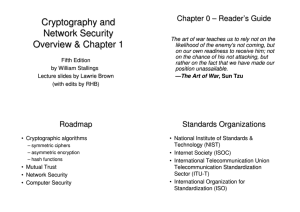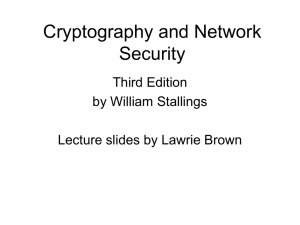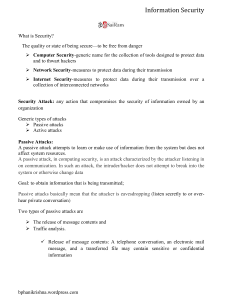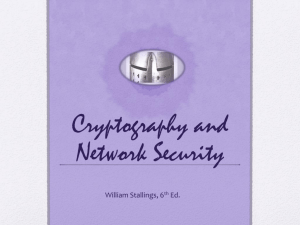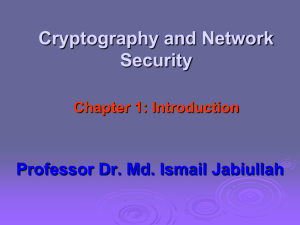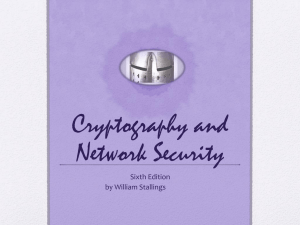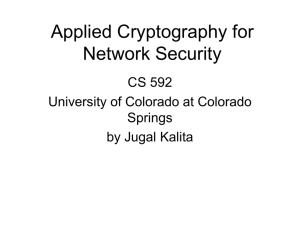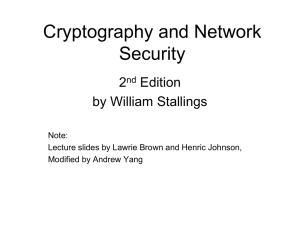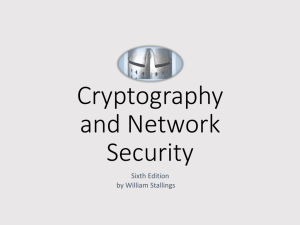William Stallings, Cryptography and Network Security 3/e
advertisement
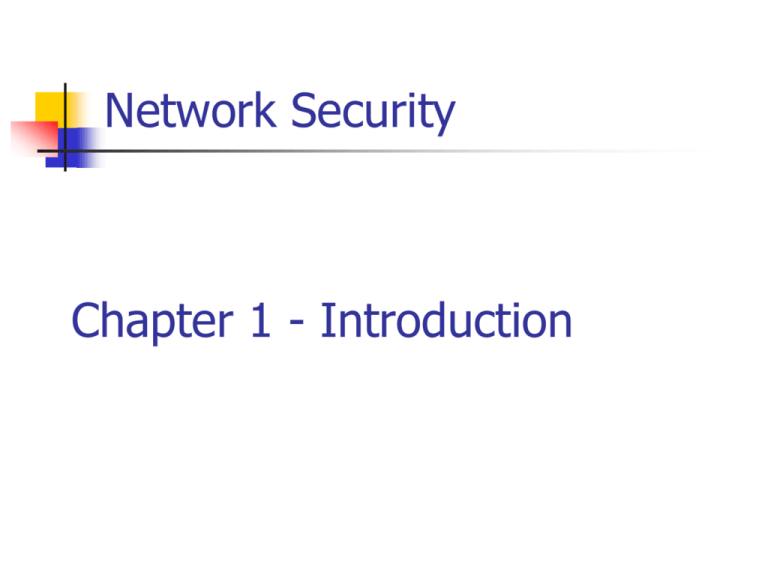
Network Security Chapter 1 - Introduction Chapter 1 – Introduction The art of war teaches us to rely not on the likelihood of the enemy's not coming, but on our own readiness to receive him; not on the chance of his not attacking, but rather on the fact that we have made our position unassailable. —The Art of War, Sun Tzu Background Information Security requirements have changed in recent times traditionally provided by physical and administrative mechanisms computer use requires automated tools to protect files and other stored information use of networks and communications links requires measures to protect data during transmission Introduction Traditionally information security provided by physical (eg. rugged filing cabinets with locks) and administrative mechanisms (eg. Personnel screening procedures during hiring process). Growing computer use implies a need for automated tools for protecting files and other information stored on it. This is especially the case for a shared system, such as a time-sharing system, and even more so for systems that can be accessed over a public telephone network, data network, or the Internet. Definitions Computer Security - generic name for the collection of tools designed to protect data and to thwart hackers Network Security - measures to protect data during their transmission Internet Security - measures to protect data during their transmission over a collection of interconnected networks Aim of Course our focus is on Network and Internet Security consists of measures to determine, prevent, detect, and correct security violations that involve the transmission of information Threat and Attack : Def Threat: A potential for violation of security, which exists when there is a circumstance. Capability, action, or event that could breach security and cause harm. Attack : An assault on system that derives from an intelligent threat I.e an Intelligent act to evade security services. Attack, Mechanism and Service Let us consider three aspects of information security: security attack security mechanism security service Please consider in reverse order so that easy to understand Security Service Security Service is something that enhances the security of the data processing systems and the information transfers of an organization intended to counter security attacks make use of one or more security mechanisms to provide the service replicate functions normally associated with physical documents eg have signatures, dates; need protection from disclosure, tampering, or destruction; be notarized or witnessed; be recorded or licensed Security Service cont.. Authentication: This is a service that is concerned with assuring that a communication is authentic. This will ensure the recipient that the message is from the source that it claims to be from. 2 aspects such as, time of connection initiation and assurance of connection is not interfered Security Service Peer entity authentication: This provides the identity of a peer entity in an association. It also establishes of data transfer during the run time. It attempts to provide confidence that any entity is not performing either a masquerade or an unauthorized replay of previous connection. Data Origin authentication: This provides the source of data unit and does not provide the duplication of data. This supports application like e-mail where there are no prior interactions between the communicating entities. Security Service cont Data Confidentiality: Confidentiality is the protection of transmitted data from passive attacks with respect to data transmission several level of protection can be identified. The broad cast service protects all user data transmitted between two systems. Data Integrity: A connection oriented integrity that deals with a stream of messages with assurance that messages are sent, without an duplication, insertion and modification. Security Mechanism a mechanism that is designed to detect, prevent, or recover from a security attack no single mechanism that will support all functions required however one particular element underlies many of the security mechanisms in use: cryptographic techniques Security Attack any action that compromises the security of information owned by an organization information security is about how to prevent attacks, or failing that, to detect attacks on information-based systems have a wide range of attacks can focus of generic types of attacks note: often threat & attack mean same Security Attack cont.. Passive Attack Passive attach are in the way of monitoring of transmission. The goal is to obtain information that is being transmitted Refer figure 1.3 in page 8 of you book passive attacks - eavesdropping on, or monitoring of, transmissions to: obtain message contents, or monitor traffic flows Active and passive threats Classify Security Attacks as active attacks – modification of data stream to: masquerade of one entity as some other replay previous messages modify messages in transit denial of service Refer figure 1.4 in page 9 of your book OSI Security Architecture ITU-T X.800 Security Architecture for OSI defines a systematic way of defining and providing security requirements for us it provides a useful, if abstract, overview of concepts we will study Security Services X.800 defines it as: a service provided by a protocol layer of communicating open systems, which ensures adequate security of the systems or of data transfers RFC 2828 defines it as: a processing or communication service provided by a system to give a specific kind of protection to system resources X.800 defines it in 5 major categories Security Services (X.800) Authentication - assurance that the communicating entity is the one claimed Access Control - prevention of the unauthorized use of a resource Data Confidentiality –protection of data from unauthorized disclosure Data Integrity - assurance that data received is as sent by an authorized entity Non-Repudiation - protection against denial by one of the parties in a communication Security threats Availability Alteration, attribution Privacy Authentication,authorization Security Mechanisms (X.800) specific security mechanisms: pervasive security mechanisms: encipherment, digital signatures, access controls, data integrity, authentication exchange, traffic padding, routing control, notarization trusted functionality, security labels, event detection, security audit trails, security recovery see Table 1.3 for details of these mechanisms, and Table 1.4 for the relationship between services and mechanisms. Model for Network Security In considering the place of encryption, its useful to use the following two models. The first models information flowing over an insecure communications channel, in the presence of possible opponents. Hence an appropriate security transform (encryption algorithm) can be used, with suitable keys, possibly negotiated using the presence of a trusted third party. Model for Network Security using this model requires us to: design a suitable algorithm for the security transformation generate the secret information (keys) used by the algorithm develop methods to distribute and share the secret information specify a protocol enabling the principals to use the transformation and secret information for a security service Model for Network Access Security The second model is concerned with controlled access to information or resources on a computer system, in the presence of possible opponents. Here appropriate controls are needed on the access and within the system, to provide suitable security. Some cryptographic techniques are useful here also. Model for Network Access Security using this model requires us to: select appropriate gatekeeper functions to identify users implement security controls to ensure only authorised users access designated information or resources trusted computer systems can be used to implement this model Summary We have considered: computer, network, internet security def’s security services, mechanisms, attacks X.800 standard models for network (access) security

![Systems Assurance [Opens in New Window]](http://s3.studylib.net/store/data/007522633_2-e364c8f93e26286779d02c826b323ed6-300x300.png)
